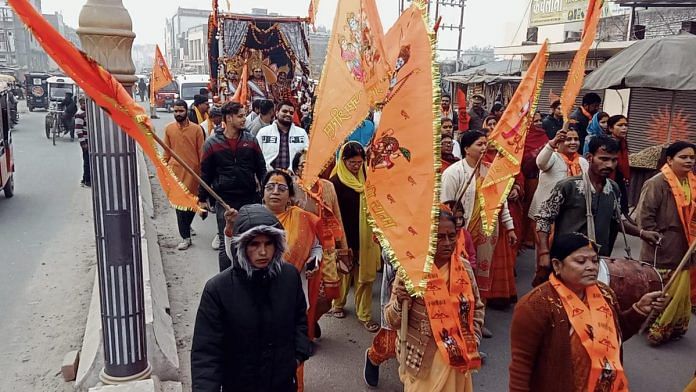Ayodhya: Braving the dense winter fog, a dozen women have gathered at the goddess Jalpa Devi temple in Ayodhya. The question hanging heavy at the meeting is this: what role will women play in the run up to and during the 22 January Pran Pratishtha ceremony of the Ram temple?
It’s complicated.
For long, Hindu women’s groups in Ayodhya were demanding and eagerly waiting for work to be assigned to them for the temple consecration. Finally, the Vishwa Hindu Parishad (VHP), the event’s central organiser, has assigned their women’s wing, Durga Vahini, only one job— to visit every home in Ayodhya and tell the families what to do on 22 January. But the Durga Vahini itself doesn’t know what to do on that day.
“Nobody has come for us. It’s humiliating. Women were at the forefront during the 90s to ensure that the Ram temple was built. We were arrested. We opened our homes to the karsevaks. And today, we have been forgotten,” says Vartika Basu, president of Durga Vahini in Ayodhya.
We are ready to even arrange footwear on the day of the consecration if they allow us to
-Sunita Srivastava, secretary of Durga Vahini in Ayodhya
At the small, nondescript Jalpa Devi temple on the edges of Ayodhya, the women squat on the floor and listen intently to Basu’s detailed instructions on what to say to families when they go knocking.
“Tell them that Ram is coming to his temple in Ayodhya after 500 years,” Basu declares, raising her right hand with a flourish. “Encourage them to light diyas and offer prayers while watching the consecration on their television.” As the women nod their heads and jot down her instructions, Basu strolls around, occasionally glancing into their diaries.
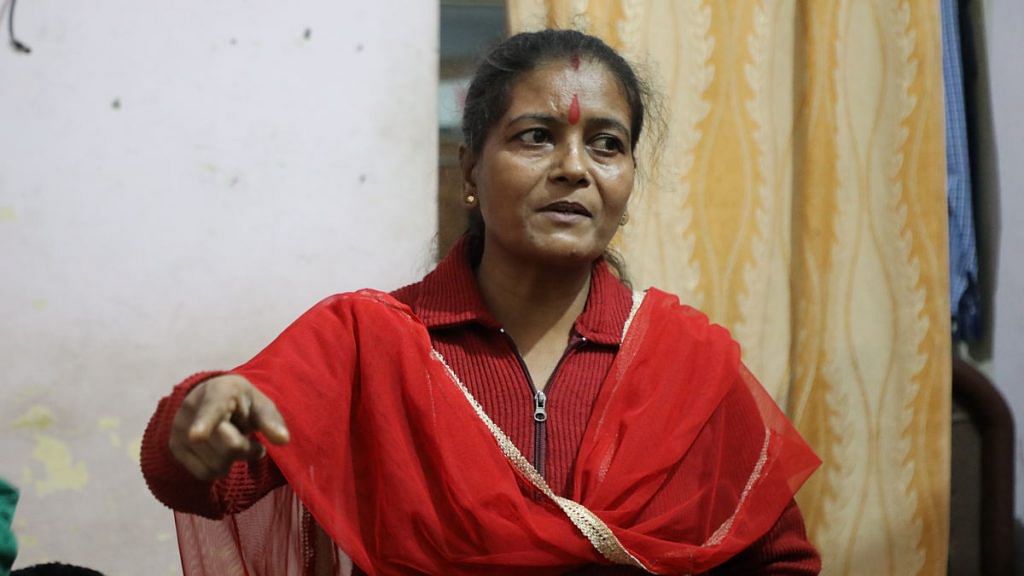
For now, the Jalpa Devi temple is their headquarters since Durga Vahini doesn’t have an office in Ayodhya. The role of women has been negligible in this final phase of the Ram Janmabhoomi movement. Unlike the 1990s, there are no visible and vocal Uma Bhartis and Sadhvi Ritambharas in the build-up to the Ram temple construction. Members of both Durga Vahini and Rashtriya Sevika Samiti, the women’s wing of the RSS, say they have been sidelined by the men who have monopolised all the work.
“We are ready to even arrange footwear on the day of the consecration if they allow us to,” says Durga Vahini secretary Sunita Srivastava, jotting down one of Basu’s instructions. “We are willing to do any work.”
While men manage VVIP invitations, tent construction, refreshments, and escorting guests, Durga Vahini had to fight for their current assignment during a meeting with Shri Ram Janmabhoomi Teerth Kshetra trustees in December 2023. For many members of Durga Vahini—the ‘Battalion of Goddess Durga’, trained in combat and in instilling a “kattar” (hardline) stance in Hindu women—this is akin to a demotion.
Nevertheless, Srivastava is spearheading the invitation drive in Ayodhya, which kicked off on 1 January, with dedication. “This is the first ever task given to women since the preparations for the Ram temple began in 2019. During the meeting, Champat Rai (Ram temple trust general secretary) said that women handle communication work better,” she says.
The women’s dream of saffron-clad Durga Vahini members lining Ayodhya’s streets on the consecration day, chanting and welcoming dignitaries and Prime Minister Narendra Modi, is fading.
Also Read: Meet the crack team behind Ayodhya’s transformation into modern temple town
‘Durga roop’ to bit players
Even the dozen women at Jalpa temple didn’t come together easily.
Basu recalls how hard it was for her to gather women for a training session ahead of the outreach mission. No one was willing to come because of the lack of meeting venues.
“After several rounds of discussions among ourselves, it was decided that we should meet at Jalpa Devi temple for the Ram temple,” she says.
The women gathered at the temple, echoing Basu’s frustration, claim they’d repeatedly requested a clear roadmap for their participation in the Ram Janmabhoomi mission from VHP vice president Champat Rai and other Sangh leaders, but received only vague assurances in return. What hurt them most, they agree, was their marginalisation during the Ram temple inauguration preparations
Many Durga Vahini members were just children or not even born when the Babri Masjid was demolished in 1992, but they have all heard about the movement’s ‘heroines’ from their mothers, aunts, grandmothers, and neighbours. When they speak about it, it’s almost as if they were there.
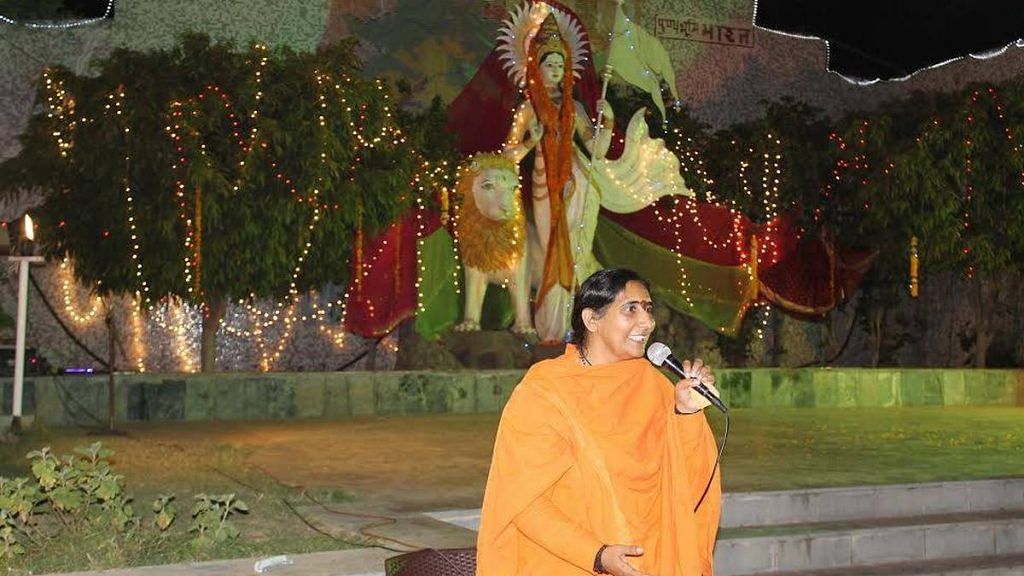
“It was Uma Bharti who raised the slogan ‘Ram Lalla hum aayenge, mandir wahi banayenge’ (We will come and we will build the temple there) from the podium,” one young woman says, requesting her name not be published.
Srivastava, who was only around 11 at the time, claims to remember the events vividly. “Sadhvi Ritambhara founded our organisation Durga Vahini. I remember she asked us to take the roop (form) of Durga and participate fearlessly in the masjid demolition,” she says. Basu, too, can think of little other than the temple and the wait for it. Even her hello tune is set to ‘Yugon Yugon ka Sapna Tha‘, a song about the generations-old Ram Temple dream.
However, when it came to the temple’s construction after the 2019 Supreme Court verdict in favour of Hindus, women faded from the picture. Even in the essential brick-and-mortar work, Ayodhya’s women were relegated to tasks like chiselling stones and carrying cement bags on their heads.
ThePrint contacted Uma Bhartia via phone to ask about the participation of women in the Ram Temple’s construction and consecration, but she declined to comment.
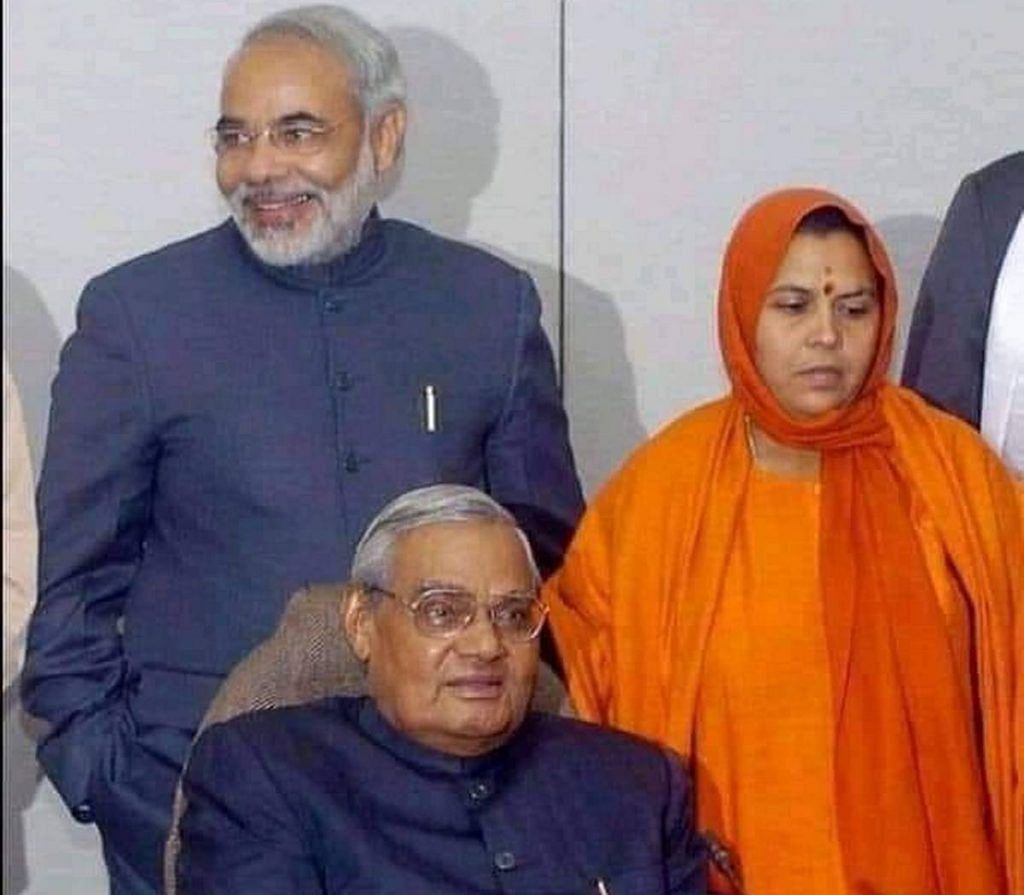
Big ‘male egos’, no money
Swati Singh was 25 when she joined Durga Vahini. A social science professor at a government college in Ayodhya, she is a sports enthusiast with a particular interest in shooting, horse riding, and sword fighting. Durga Vahini’s emphasis on self-defence and combat skills for women, therefore, appealed to her. “It made me feel that if I learn all these techniques, I wouldn’t need men for my safety. I could do it for myself,” Singh says.
Another member, Divyanaka Rathor, 29, was also attracted to the firebrand image of Durga Vahini. She discreetly participates in the organisation’s activities despite disapproval from her parents. “There is a perception that Durga Vahini are aimless women with no real work,” Rathor says.
When ABVP, RSS, and VHP can have offices, so why can’t we? Their (men’s) ego is hurt by us and that’s why they sideline women
-Divyanaka Rathor, Durga Vahini member
As dark settles over Ayodhya on a December evening, Singh and Rathor join Vartika Basu in her two-storey house. Basu is trying to make them understand the importance of Durga Vahini and its role during the Ram Janmabhoomi movement in the 1990s.
Basu has invited two other women for a pep talk too, but they haven’t turned up. She says she wakes up at 4 am, cooks for her family, reads the paper, and by 10 am sharp starts with her outreach work. But it’s been difficult to recruit other workers with the same dedication, even among the 25 members she has pulled together over the last two years.
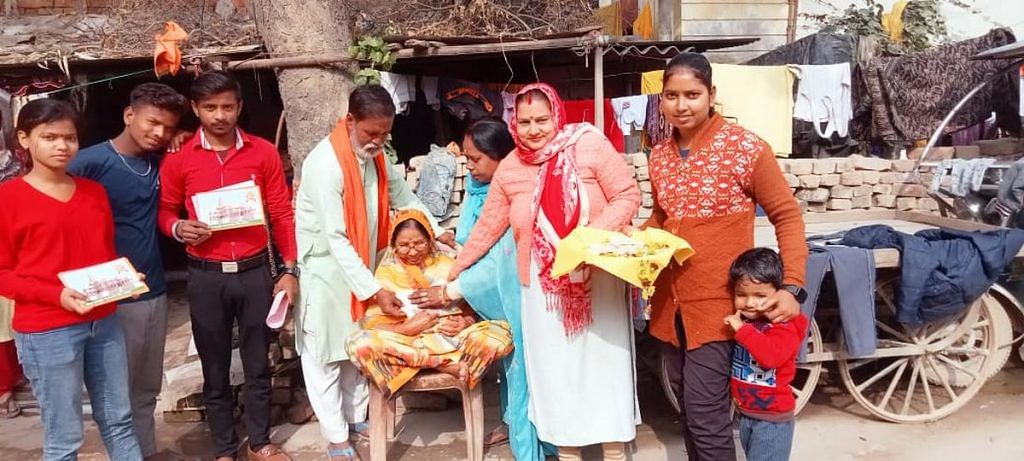
“Where has the fire gone? You are Durgas. Become one and know your potential,” Basu exhorts.
Rathor stares at her. “But Durgas need some money if you want them to be full-time members. We have families to look after,” she argues.
Basu pauses and swiftly sits down on the chair, holding her head in frustration.
“I can’t run the Durga Vahini alone, without your support,” she says, while accepting in the same breath that women need some reimbursement and acknowledgement.
Rathor joined Durga Vahini three years ago. She recounts that she once brimmed with enthusiasm, but is now disillusioned. Her dream of saffron-clad Durga Vahini members lining Ayodhya’s streets on the consecration day, chanting and welcoming dignitaries and Prime Minister Narendra Modi, is fading. “It won’t happen,” she says. Strains of music float in from the hall where Basu’s daughter and other singers are practicing for a recital for the Ayodhya Mahotsav programme ahead of the consecration.
Women have been given work that the seniors thought was suited for them. They are our mothers and sisters and are driving the entire consecration event
-Sharad Sharma, senior VHP leader
“Our leaders such as Vartika and Sunita have been asked to attend to the women participants after the consecration. But we will be invisible, watching on TV just like others,” Rathor adds. The only things that can revive her interest now, she says, are basic reimbursement, an office, and appropriate acknowledgement from the VHP.
“When ABVP, RSS, and VHP can have offices, so why can’t we? Their (men’s) ego is hurt by us and that’s why they sideline women,” Rathor says, grabbing her bag to leave as her brother honks his motorbike.
Within the 10-acre complex of the VHP’s Karsevakpuram, several temporary tin-roof shelters have been erected to house male sadhus, VHP members, and RSS cadres. But there are no dedicated spaces for women, nor any portraits.
A woman’s place—at home and in ‘battle’
Located about 15 kilometres from Jalpa Devi temple is Karsevakpuram. Once a meeting point for karsevaks, it now stands as an expansive office of the VHP and its pracharaks and karyakartas. Giant portraits of the late former VHP president Ashok Singhal, one of the leaders of the Ram Janmabhoomi movement, dominate the entrance pillars.
Within the 10-acre complex, several temporary tin-roof shelters have been erected to house male sadhus, VHP members, and RSS cadres. But there are no dedicated spaces for women, nor any portraits. Members of Durga Vahini claim that their requests for even a small office at Karsevakpuram have been consistently denied.
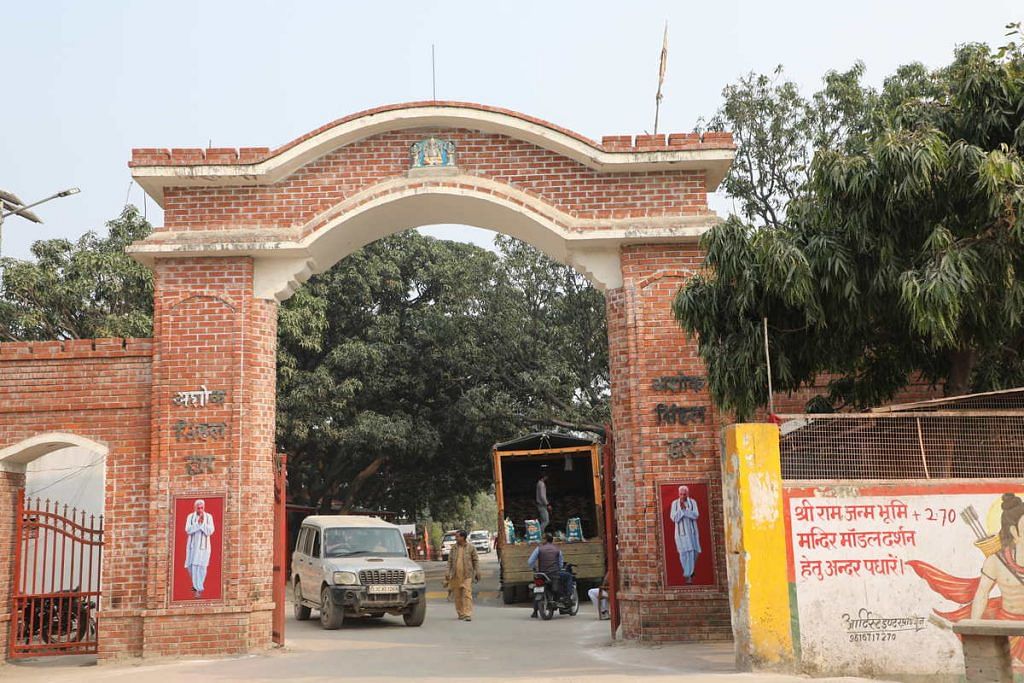
“During meetings, we are told that women should take care of their families first and then work for society,” says a Durga Vahini member, requesting anonymity.
VHP members at Karsevakpuram attribute this to their ideological stance.
“In our culture and the ideology we impart, women and men cannot exist in the same complex. We are looking for a site for their office,” says a VHP functionary, asking that his identity not be disclosed.
Ironically, however, Karsevakpuram is where the VHP also holds arms training camps for women. These Shourya Prashikhan Shivir, or ‘bravery training camps’, take place at different complexes of RSS and VHP across India.
Women stay at the VHP complex and are trained to use sticks, swords, and guns
-Vartika Basu, Durga Vahini president in Ayodhya
“Every year, we have a training course of 10 days. In 2022, it was in Gujarat. In 2023, it was in Karsevakpuram. Women stay at the VHP complex and are trained to use sticks, swords, and guns,” Basu says. They are also given religious instruction and primed on skills to make other Hindu women “kattar” too.
“When women are trained like men to fight the evils in society. Why are they segregated?” asks Srivastava, with Basu chiming in her agreement.
They have not received the answers to that question in the last 30 years.
Senior VHP leader Sharad Sharma, a close aide of Ram Janmabhoomi kshetra trust chief Champat Rai, says that women have been given Pran Pratishtha-related tasks that are best matched to their skills.
“Women have been given work that the seniors thought was suited for them,” Sharma explains, even as he struggles to recall the Durga Vahini president’s name. “They are our mothers and sisters and are driving the entire consecration event.”
Also Read: Ayodhya joy sweeps NCR RWAs. LED screens, Ram recitals, temple replicas, havans
‘Men can do it better’
Vartika Basu was made the Ayodhya president of Durga Vahini in 2021. Before that, she headed the grameen (village) department of the organisation, connecting with young women at temples and guiding them on Hindu womanhood. She was zealous about recruitment. Armed with a notebook, Basu would jot down the names and phone numbers of girls she’d meet and even contact their parents to persuade them about the benefits of joining Durga Vahini.
“I would tell parents that Durga Vahini would make their daughters religiously, mentally, and physically sound. I’d show them videos of the members on my phone,” Basu recalls.
Back then, Basu was a well-known figure in the villages adjoining Ayodhya and the Sangh leadership took note too. But what was supposed to be a promotion in Ayodhya city turned out to be a deep disappointment. The VHP leadership ignored her and she had to fight for her place at the table for meetings.
Basu and Srivastava also took it upon themselves to breathe new life into Durga Vahini in Ayodhya. “We felt that the women here lacked enthusiasm and there were no avenues for them,” says Basu.
However, little has changed despite their concerted efforts. “Whenever we are needed, the VHP calls us for a meeting and that’s when we women meet and greet each other,” Sunita says. The memory of her request for an office being turned down and the whole room going silent at one such meeting still stings, she says.
“It feels like we don’t exist. There are no history books on our role in the Ram Janambhoomi movement,” rues Sunita, leaving to invite another family.
It’s a similar story in the RSS’ Rashtra Sevika Samiti. Sonali Gaur, a prominent member of the organisation in Ayodhya, says the women were disappointed that no important work was given to them, But she quickly adds that they were not capable of handling bigger responsibilities either. She notes that after the Ram temple opens to devotees, the Sangh’s women will attend to the female sadhvis coming to Ayodhya.
“There is no point in complaining. This is Ram’s work,” Gaur says. “It is disappointing but I believe men can do it better. And let’s accept that.”
(Edited by Asavari Singh)


